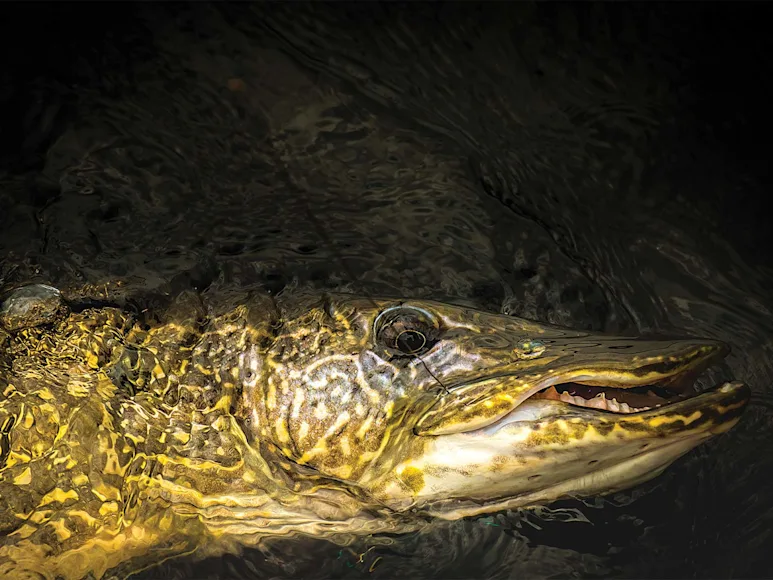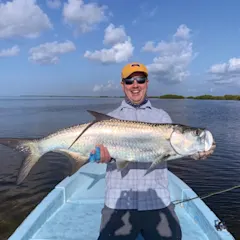After our guide cut the outboard, I grabbed my fly rod, stepped up to the bow deck, and surveyed the scene. It had been a long, exhausting journey from my home in New York to way-way-way-northern Manitoba—four flights in two days, the last of which was a short stint in a floatplane that dropped us off at our fish camp on the Cree River—but the boat ride to the pike grounds
was restorative. I was ready to fish.
I double-hauled toward the riverbank and stripped my streamer once, and a fish struck. The pike was small, but I couldn’t help but smile at the fact that I had landed one on my first cast. And again on my second… And on my third…
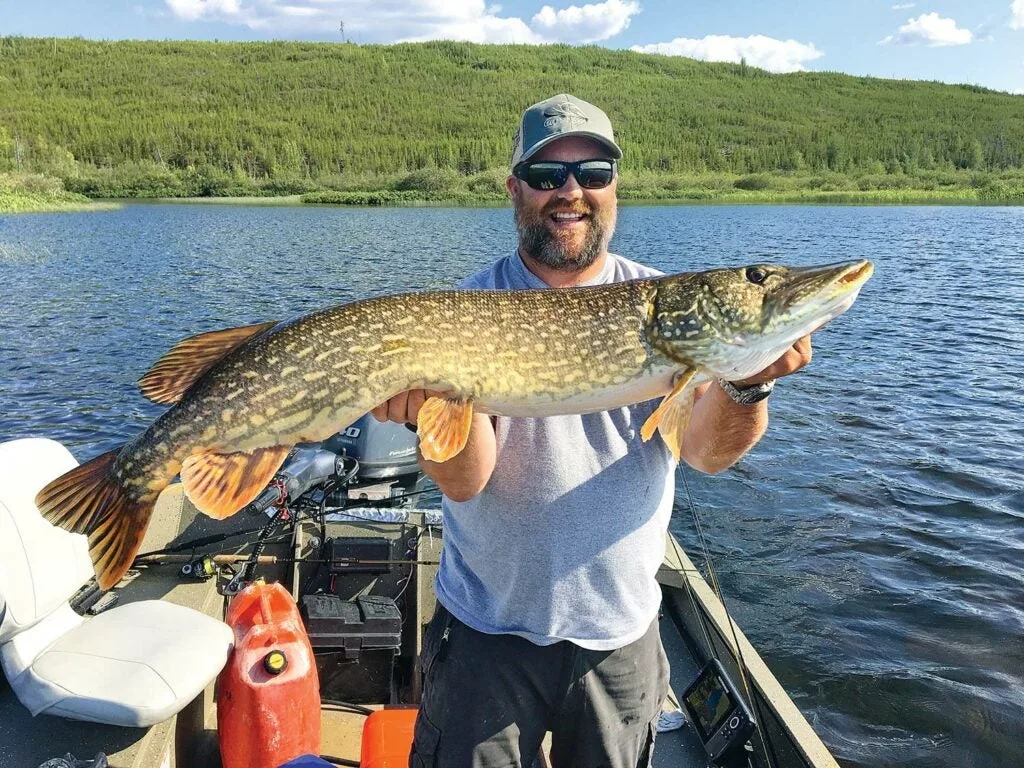
Cree River Lodge owner Pat Babcock shows off a trophy pike before releasing it. Colin Kearns
All of the fish so far were hammer-handles, but the takes were strong and, best of all, visual. Even in water as clear as the Cree’s, the chains that run along the flanks of a pike camouflage the fish so naturally that you don’t see one till it appears from nowhere to kill your fly. My consecutive-strike streak ended at three, but the bites remained constant, and the fish got bigger—up to 37 inches. And after I released yet another fish, I remember thinking, Where the hell am I? Right on cue, my buddy Brad Fenson
, who’d been matching me pike for pike, shared some advice.
“Be sure to take some moments this week just to appreciate where you are,” he said. Unlike me, Fenson has fished these waters and stayed at this camp many times before. He knows how incredible it is here. “It’s easy to keep casting and casting because you just want to catch more fish—but try to slow down now and then and just enjoy this place.”
I thanked him, then just stood there on the bow for a moment, gazing at the water and feeling it gently pulse beneath my feet. An eagle glided over the river. The sun had fallen, and the air had chilled. Soon we’d need to return to camp for the night—but not quite yet. So I fired another cast.
Gator Country
The next morning, my friend Jesse Riding and I jumped into Pat Babcock’s boat. We had a long ride ahead of us—almost two hours—but Babcock promised it’d be worth the trek. We were off to hunt monsters.
Could we have stayed closer to camp and gotten after some trophy walleyes
and lake trout? Sure. But the real draw to a fly-in camp like Cree River Lodge
is northern pike. Nowhere on Earth will you experience better fishing for Esox lucius than in a place like this. The conditions—a steady flow of cold, clean water, an abundance of forage—are pitch-perfect for a healthy population of pike. And because these rivers and lakes are so remote, the fish see relatively little angling pressure and are eager to strike lures and flies alike; these fish don’t discriminate. And as for the size of these pike? Expect to be spoiled by so many 30-plus-inchers that you’ll forget what a trophy that kind of pike would be back home. Expect to catch a few in the low- to mid-40s during your trip. And expect a couple of lucky souls in camp to net northerns that flirt with the 50-inch mark on the tape. So, while I can appreciate a big walleye or lake trout, if I have to choose between jigging or trolling with my eyes glued to a fish-finder and sight-casting to trophy pike, I’m taking northerns every time—even if it means starting the day with a lengthy boat ride.
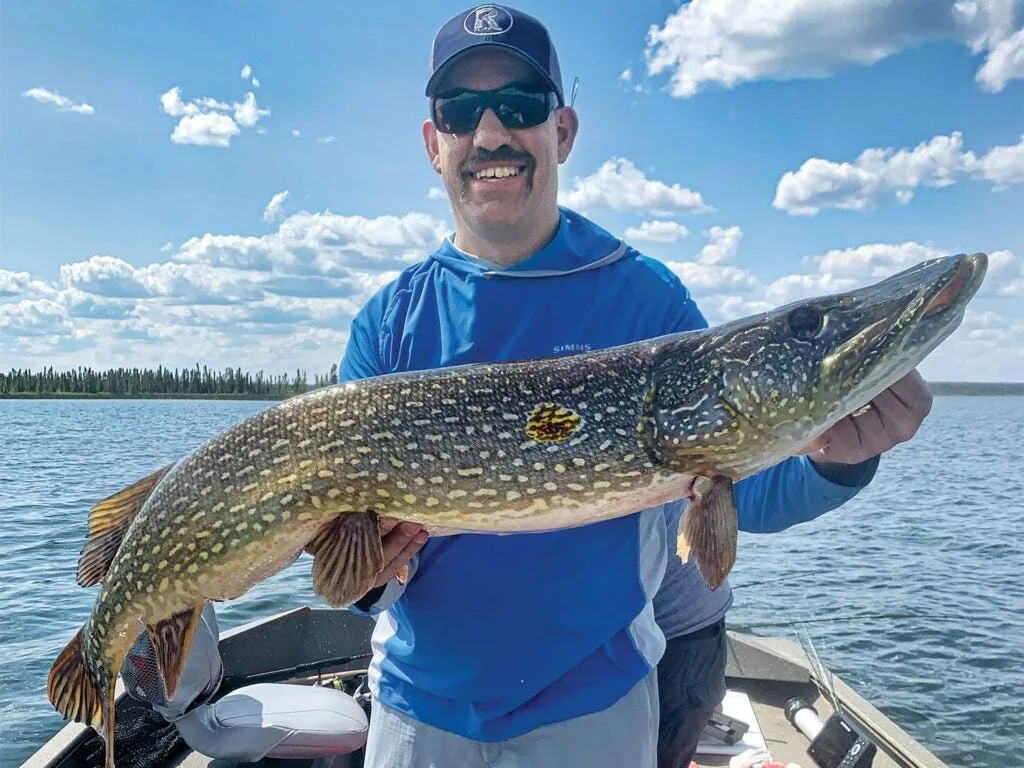
One afternoon, Jesse Riding landed two pike over 40 inches before lunch. Colin Kearns
As Babcock navigated through the tight and winding channels, Riding said the setting reminded him of Florida backwaters. “Have any gators up here?” he joked.
“No,” Babcock said. “Just big pike.”
The blackened skeletons of jack pines left standing after a long-ago wildfire loomed over the river, but the banks and surrounding hills were lush with more shades of green than I had ever seen before. We eventually came to a stop in a large bay, and Babcock told us to cast. Riding took the bow as I positioned myself in the middle, then we cast to opposite sides of the boat. What happened for the next hour is bit of a blur, but I remember the strikes came instantly.
Riding: small pike… Me: small pike… Riding: small pike… Me: something big—
My 8-weight doubled over more than it had for as long as I’ve owned it. The fish made runs, but I kept it from entering the thick, snag-inviting vegetation before ultimately guiding it toward Babcock’s hand reaching over the gunnel. He taped the pike at 40 ½ inches, then released it. I said it was the biggest northern I’d ever caught on the fly. He smiled and said, “Just wait.”
The wait wasn’t long.
Riding: small pike… Me: small pike… Me: something even bigger—
A white streak flashed past the boat. “Oh,” Babcock said. “That’s a nice fish.” The fight felt like a round of tug-of-war. At any second, it seemed like the pike was going to rip the rod out of my hand and take it into the weeds. I’d never felt greater strength in a fish than I did in that northern. Again, that where-the-hell-am-I thought popped into my head. The hookset was solid, my knots held true, and, little by little, I gained line until I was able to guide the pike to Babcock’s hand.
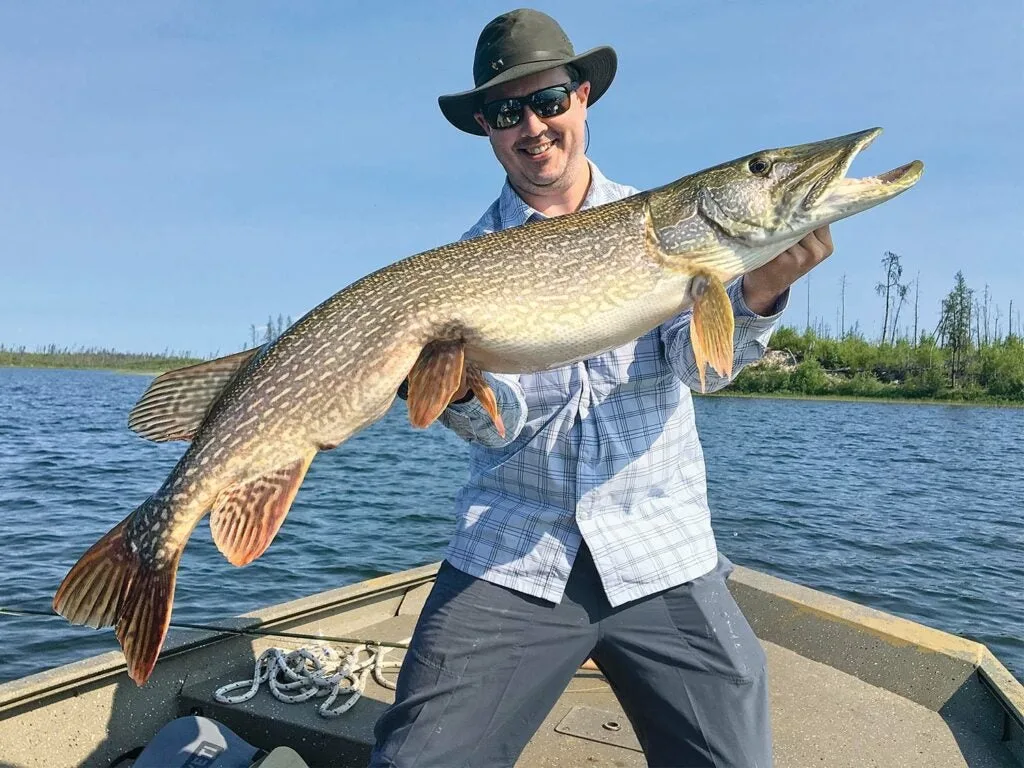
The author hoists his biggest pike of the trip (and his life), a 47-incher. Colin Kearns
He seemed to hoist the fish out of the water in slow motion. I kept waiting for the tail to emerge, but the body kept going…and going…and going. Turns out, 47 inches is a lot of northern pike. After we released the fish, I plopped down on the bow deck, then fell on my back. I remembered Fenson’s advice as I stayed there, elated, gazing at the sky. I took a moment longer to enjoy this place.
Hours later, Babcock jumped the boat on plane as he took us to one last spot for the day. I inspected my aching hands. They were scraped and cut from handling so many pike. Blood stained the cork on my fly rod. Between Riding and me, we’d caught more than 100 fish—including 41- and 43-inchers that Riding scored—and every one of them had bitten a streamer. Big bugs in either chartreuse or purple triggered the most takes, but the flies didn’t have a very long shelf life. After a half dozen strikes, a streamer would look as beat-up and bloodied as my hands.
Because we’d done so well on streamers, Riding and I asked Babcock if we could finish in a spot where we could work the surface. He took us to a bay protected from the wind and loaded with structure—vegetation, stumps, blowdowns. We flung foam meat platters that popped, gurgled, and left appetizing wakes. Nothing moved at first, but eventually a few pike came out of the shadows. Clouds of mud and sand billowed in the water from where the fish had been hiding. I lobbed my fly to one 15 feet from the boat. The fish curled around to the commotion and slid directly beneath the fly. Time to ring the dinner bell, I thought. I made two quick strips. The pike rose, opened its maw, and vacuumed up the fly.
The pike measured 42 inches. “That’s a good fish to end on,” Babcock said. No arguments from anyone.

The welcome sign outside Cree River Lodge. Colin Kearns
Summer Camp
As much as I would’ve liked to keep fishing well into the night, it was fun to get back to camp in the evenings. In addition to our group of four, there were a father-son pair, another crew of four buddies who live in different cities but get together annually for a fishing trip, and a lone doctor who travels the world hunting giant fish. By the second night, we’d all gotten friendly with one another, and after unloading our gear and freshening up, we’d meet in the dining room for drinks and to trade stories about our days on the water. Is there any setting better suited for good conversation and fellowship than a camp with the utter absence of wifi and cell service?
The camp staff hung out with us too. That second night, a few hours after dinner, one of the guides prepared a second supper for us all, grilling poppers and venison sausage. I ate more than I needed to and stayed up later than I meant to. I blame it on the extended hours of summer sunlight and the atmosphere and camaraderie of a great camp.
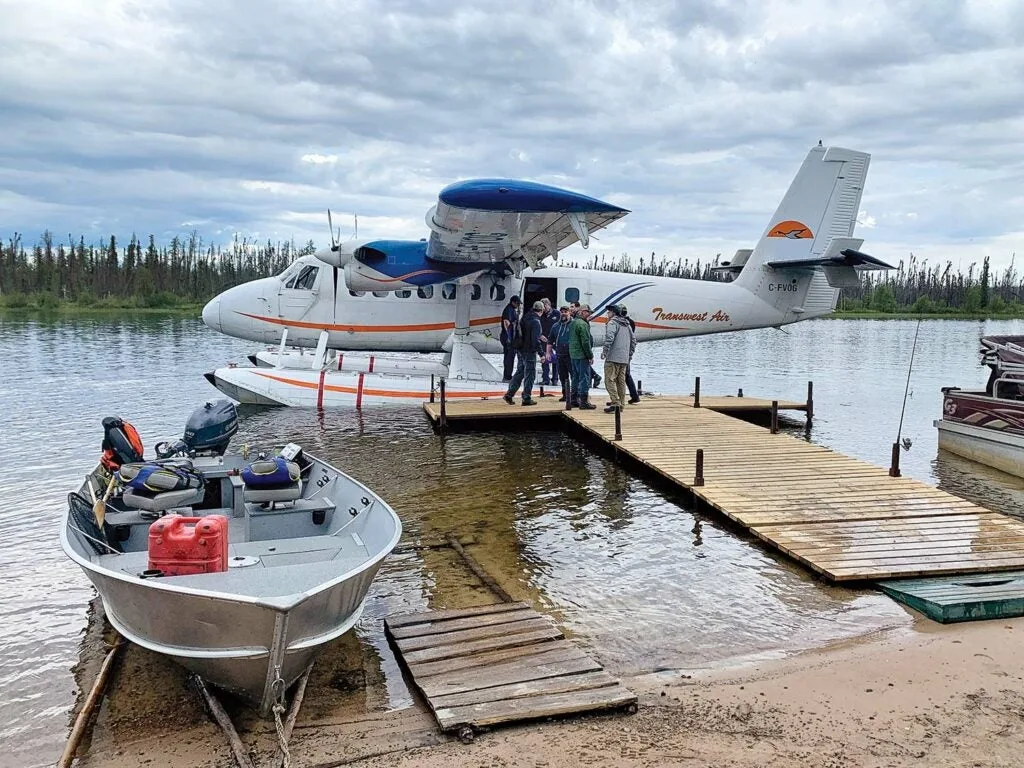
A floatplane drops off a crew of anglers at camp. Colin Kearns
One Last Cast
On the final day, I teamed up with my pal Brooks Hansen. By this point, we’d landed more than our share of pike, so we were willing to sacrifice the morning to one other species you can catch in the Cree, one that’s been on my bucket list for decades—grayling.
I was nervous standing on that bow, not knowing when I’d have another chance to cast for these strange, beautiful fish. The 4-weight rod felt like a feather compared to the 8 that I had been throwing all week, and my casting was sloppy. The stiff wind wasn’t helping either. Babcock held the boat in a stretch of swift current that didn’t allow for long drifts. On top of all that, the fish weren’t rising. I was casting blind and without much hope.
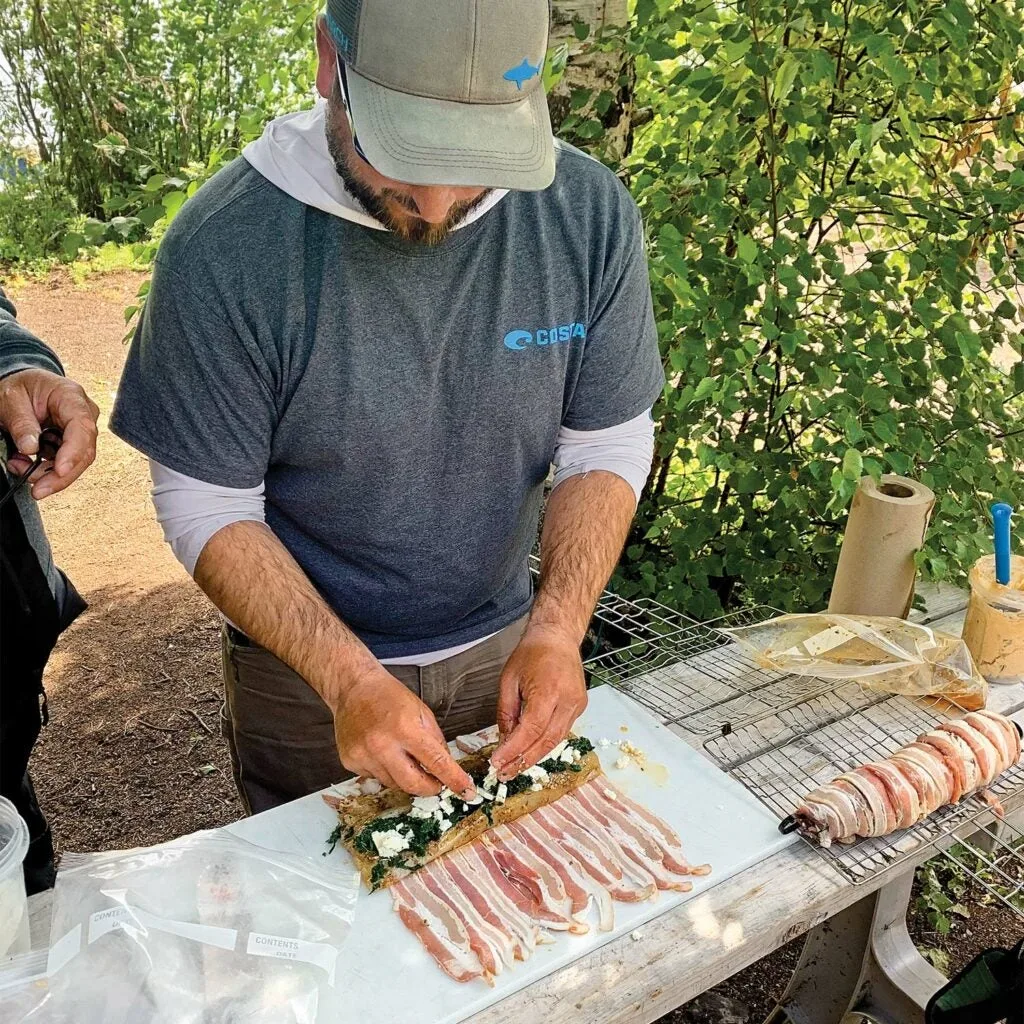
Fishing guide Adam George preps bacon-wrapped pike fillets stuffed with cream cheese and spinach. Colin Kearns
Then a grayling rose. And I missed the strike.
I cursed myself for screwing up what I assumed would be my only chance, but Babcock spotted another rise downstream. He repositioned the boat, then I cast to the seam where the fish had surfaced.
The grayling rose again. And I set the hook.
Babcock and Hansen cheered. I watched the fish jump a couple of times before I stripped it in. Holding the rod tip high, I suspended the fish in the water just beside the boat and marveled at its colors. They were remarkable. The river’s glare from the faint morning sunlight flashed off the grayling’s dorsal fin and flanks, morphing from silver to blue to green to purple. I felt like I was watching the Northern Lights reflect onto my fish.
With the grayling mission accomplished, Hansen and I spent the rest of the day catching the piss out of pike. We even lucked into a handful of walleyes on the fly. None of the northerns measured more than in the high 30s, but we couldn’t have cared less about trophies at this point. We were too busy laughing at the luck that brought us to this amazing place. We probably had 50 fish before lunch and went on to net another 50 afterward.
For the entire afternoon, I kept the same fly—a black streamer with a grizzly-hackle collar and a touch of red on its head. The fish found it irresistible. But it was the last of its kind in my box, and with each bite, it got more and more mangled. Same with my wire leader—also the last one I had left. Both were on their final legs just as the day, and our trip, was nearing its end.
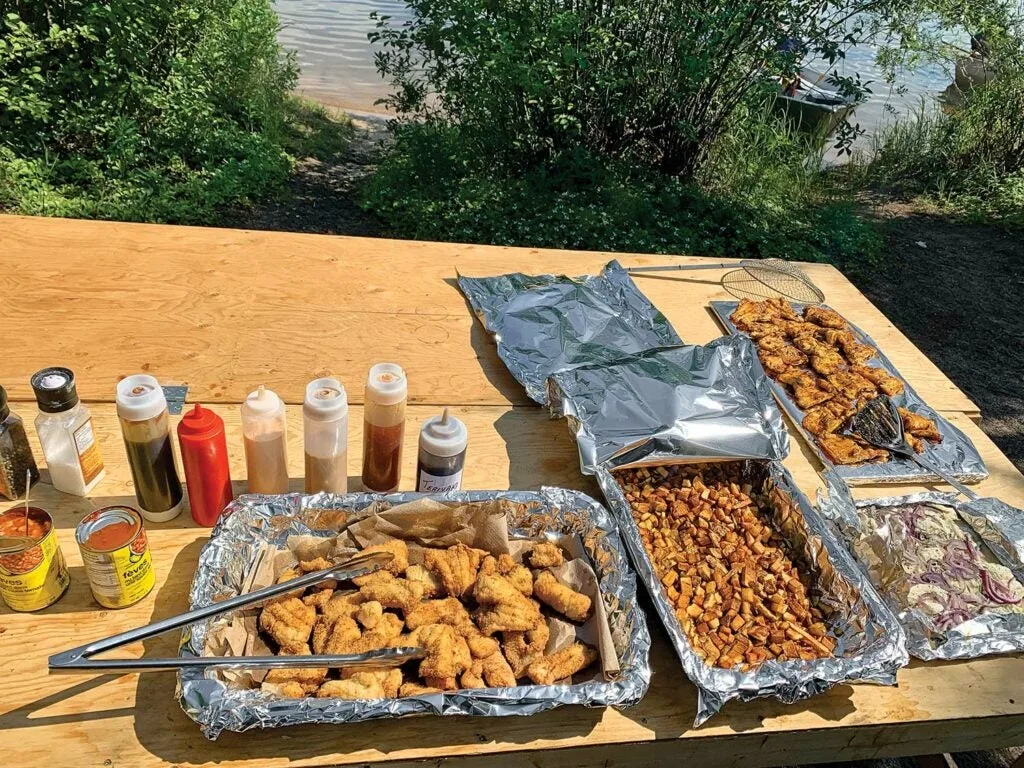
Come and get it—shore lunch is served. Colin Kearns
We motored into one more bay, and I promptly landed another hammer-handle. When I released it, I saw that the arm on my snap swivel had broken and that the fly was just barely holding on. I grinned. What the hell?
I cast to the edge of some grass and could see that the fly was still there. I made one strip; still there—and now a pike had entered the picture. I got greedy and stripped once more. The fly, and the fish, were gone.
I reeled in my line and relinquished the bow to Hansen. As I broke down my rod, Fenson’s advice, once more, came to mind, and so I sat back and took a moment to enjoy exactly where I was—at the end of one of the best fishing trips of my life, watching my friend hook one more pike on his last cast.
He released the fish, and we cruised back to camp.
Tip: How to Cook the Ultimate Shore Lunch

Heaven on a plate. Colin Kearns
Fish camp wouldn’t be fish camp without a shore lunch—and I’m not exaggerating when I say that the shore lunches that the Cree River Lodge guides prepared rivaled the fishing. O.K., maybe I’m exaggerating a little, but they were the best shore lunches I have ever had. Here’s how you can replicate these amazing feasts.
Kitchen upgrade: Sure, it’s fun to cook over an open fire, but a stove is easier to work with and gives you more control. A Camp Chef Pro60x ($275; campchef.com
) was the workhorse of our shore kitchen.
Have the Usual: This is a shore lunch, so walleye and pike fillets, dredged in seasoned flour and deep-fried in hot oil, must be on the menu. Same goes for fried spuds, baked beans, and creamed corn.
Catch of the Day: In addition to the fried fillets, a different fish dish was added to each day’s menu. My two favorites were blackened pike fillets and bacon-wrapped pike stuffed with cream cheese, smoked salmon, and jalapeños.
Get Sauced: No, I’m not talking about a cooler full of Labatt Blue. I’m talking dipping sauces, of which the Cree River guides had a delicious stockpile—teriyaki, garlic mayo, hoisin, and, my favorite, sweet chile.
Easy There: Going back for seconds is perfectly fine, but beware of thirds. Remember, you still have to fish in the hot sun all afternoon.

